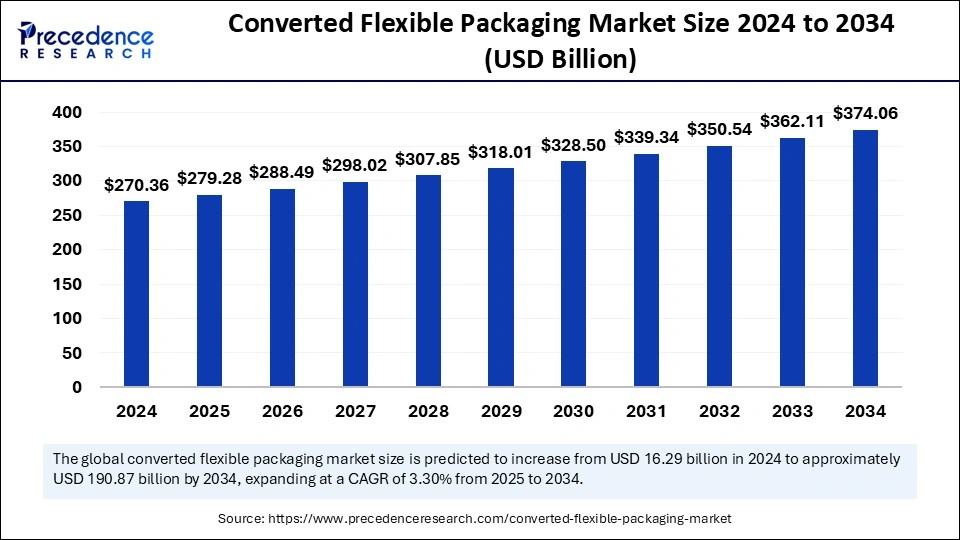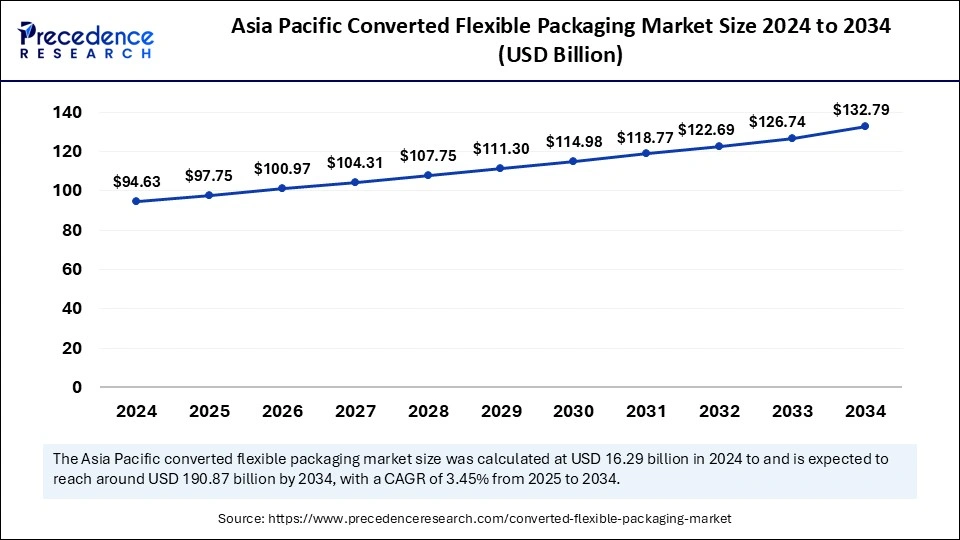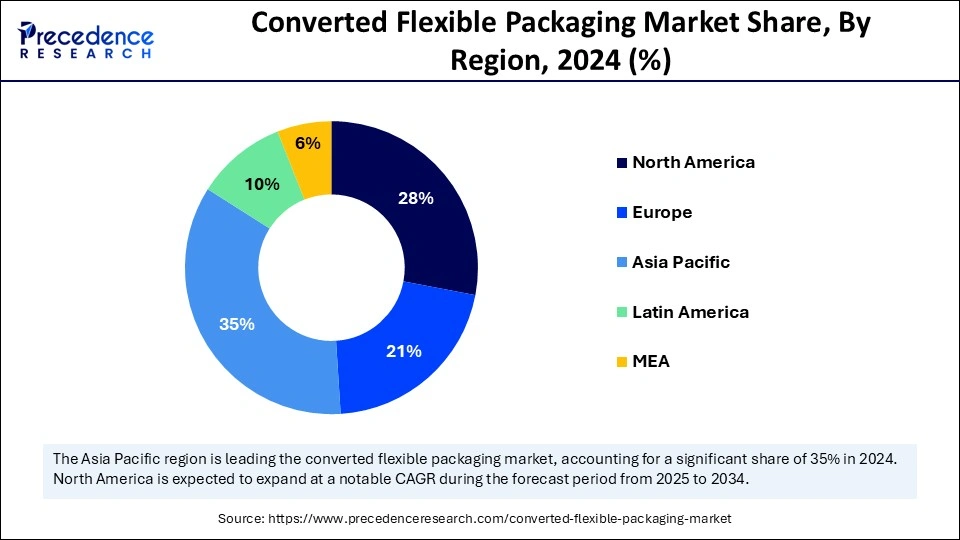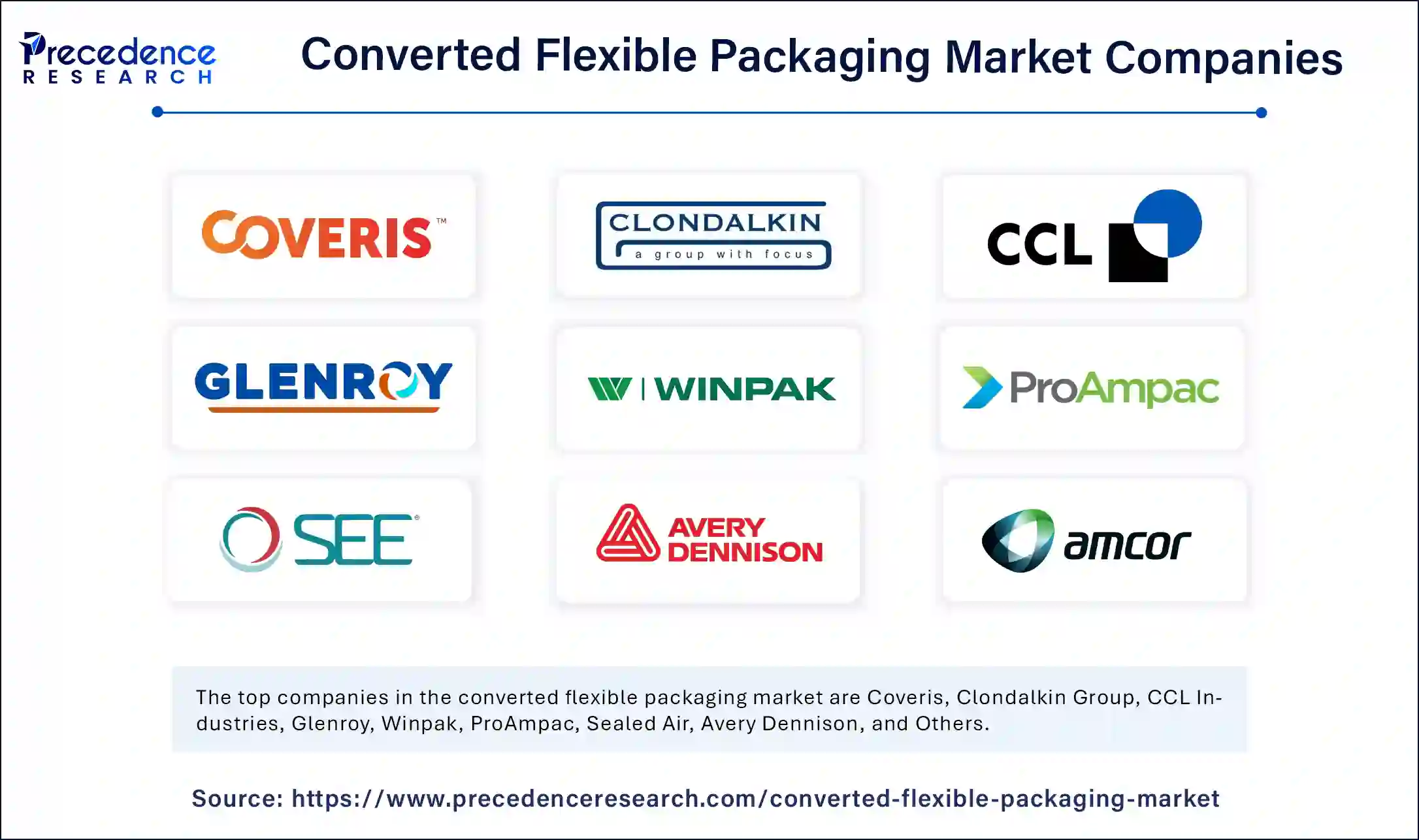January 2025
The global converted flexible packaging market size is calculated at USD 279.28 billion in 2025 and is forecasted to reach around USD 374.06 billion by 2034, accelerating at a CAGR of 3.30% from 2025 to 2034. The Asia Pacific market size surpassed USD 94.63 billion in 2024 and is expanding at a CAGR of 3.45% during the forecast period. The market sizing and forecasts are revenue-based (USD Million/Billion), with 2024 as the base year.
The global converted flexible packaging market size accounted for USD 270.36 billion in 2024 and is predicted to increase from USD 279.28 billion in 2025 to approximately USD 374.06 billion by 2034, expanding at a CAGR of 3.30% from 2025 to 2034 The growth of the converted flexible packaging market is driven by the growing consumer desire for convenient and portable packaging options. Moreover, rising sustainability concerns are expected to boost the growth of the market during the period studied.

Artificial intelligence (AI) is reshaping the converted flexible packaging market by boosting manufacturing efficiency, optimizing material use, enhancing sustainability, and facilitating smart packaging innovations. Machine learning algorithms powered by AI enable manufacturers to evaluate production data, predict material waste, and improve resource utilization, which leads to cost reductions and lower environmental footprints. Automated quality control systems utilizing AI employ computer vision and real-time monitoring to identify defects in flexible packaging, assuring greater precision and minimizing material waste. Moreover, AI is integral to advancements in smart packaging technologies, such as printed electronics, QR codes, and RFID tags. These innovations allow for real-time tracking of products, validation, and improved consumer interaction.
AI-integrated packaging can create dynamic product experiences by offering personalized suggestions and enhancing supply chain transparency. In terms of sustainability initiatives, AI supports the development of biodegradable and recyclable materials by analyzing chemical properties and performance attributes and providing eco-friendly packaging solutions. Furthermore, AI-enabled predictive maintenance systems in flexible packaging facilities aid in minimizing downtime, boosting equipment performance, and reducing production disruptions. With continual progress in AI-driven automation and data analytics, the converted flexible packaging market is poised for greater efficiency, innovation, and enhanced environmental sustainability, leading to growth and competitive benefits for manufacturers.
The Asia Pacific converted flexible packaging market size was exhibited at USD 94.63 billion in 2024 and is projected to be worth around USD 132.79 billion by 2034, growing at a CAGR of 3.45% from 2025 to 2034.

Asia Pacific Converted Flexible Packaging Market Trends
Asia Pacific dominated the market with the largest share in 2024. This is mainly due to rapid industrial growth, increased demand for packaged products, and the presence of key packaging manufacturers. This region hosts major producers of flexible packaging that serve sectors such as food & beverages, pharmaceuticals, and personal care. The growing middle-class population, rising disposable incomes, and evolving consumer preferences for convenient and sustainable packaging options are further driving market growth. Additionally, the expansion of e-commerce and online grocery shopping has heightened the need for flexible pouches, bags, and films for transport and storage.
China
China represents the largest market for converted flexible packaging, bolstered by strong manufacturing capabilities, significant demand for packaged products, and governmental initiatives advocating for sustainable packaging. The nation has enforced stringent regulations on plastic waste, motivating businesses to adopt biodegradable and recyclable materials. The surge in online food delivery and retail packaging is increasing the demand for lightweight, durable, and resealable packaging solutions. Furthermore, leading Chinese packaging companies are investing in cutting-edge printing technologies and smart packaging innovations, further fueling market growth.

India
India is witnessing rapid development in the converted flexible packaging market, propelled by urban development, a heightened consumer preference for packaged foods, and governmental support for sustainable packaging alternatives. The flourishing e-commerce sector has increased demand for flexible packaging materials like stand-up pouches, zip-lock bags, and laminated films. Additionally, India's efforts to prohibit single-use plastics have spurred advancements in biodegradable and compostable packaging options. With surging demand for flexible, green packaging solutions within the food, pharmaceutical, and personal care industries, India's market is set for significant growth.
North American Converted Flexible Packaging Market Trends
North America is expected to witness the fastest growth during the forecast period due to the increasing demand for eco-friendly packaging, advanced printing technologies, and the emergence of smart packaging solutions. The region benefits from a robust regulatory environment, with governments advocating for environmentally friendly packaging alternatives and initiatives to reduce plastic waste. The expansion of the organic food, pharmaceutical, and personal care sectors is further driving the need for high-barrier, resealable, and tamper-proof packaging. Additionally, the presence of leading packaging manufacturers and advancements in packaging technologies are expected to foster market growth.
United States
The U.S. is likely to have a stronghold on the North American converted flexible packaging market. This is due to the growing demand for sustainable and lightweight packaging options. Companies are increasingly investing in biodegradable and recyclable packaging materials, in line with governmental regulations on plastic waste reduction. The rise of direct-to-consumer brands, meal delivery services, and convenience food products has also contributed to the demand for pouches, flexible films, and smart packaging technologies. The use of AI-driven packaging automation and RFID tracking systems is enhancing supply chain efficiency and engaging consumers.
Canada
Canada's converted flexible packaging market is set to expand at a rapid pace due to government initiatives that promote sustainable packaging, strong demand for packaged products, and a growing focus on waste reduction policies. The country has introduced extended producer responsibility programs, encouraging companies to utilize recyclable and compostable materials. Moreover, the growth of organic food markets, personal care brands, and pharmaceutical industries is driving the need for flexible pouches, high-barrier films, and smart packaging solutions. The incorporation of QR codes and NFC-enabled packaging for product authentication and consumer interaction is further propelling market growth.
European Converted Flexible Packaging Market Trends
Europe is considered to be a significantly growing area, driven by strict environmental regulations, a high rate of sustainable packaging material adoption, and a rising demand for innovative packaging solutions. The European Union's commitment to circular economy initiatives and ban on single-use plastics is expected to support regional market growth. Leading brands are transitioning to recyclable, compostable, and fiber-based packaging materials, fostering innovation in eco-friendly solutions.
Germany
Germany stands as one of the largest markets for converted flexible packaging within Europe, influenced by technological advancements, stringent regulations on plastic waste, and a well-established packaging industry. The nation has enacted strict recycling laws under the Packaging Act, motivating companies to pursue sustainable and recyclable packaging options. German packaging manufacturers are investing in advanced printing technologies, high-barrier films, and AI-driven smart packaging innovations. The increasing need for organic food packaging, pharmaceuticals, and eco-friendly e-commerce packaging is expected to drive market growth.
France
France is a significant contributor to the converted flexible packaging market, supported by government initiatives that ban plastic waste and encourage biodegradable alternatives. The rapid shift toward compostable materials, plant-based packaging, and fiber-based substitutes is picking up pace across the food, beverage, and personal care industries. French firms are increasingly incorporating smart packaging elements, such as QR codes and interactive labels, to enhance brand interaction and supply chain visibility. The nation's emphasis on minimizing food waste through innovative packaging solutions, including active and intelligent packaging, is likely to boost the demand for converted flexible packaging solutions.
The converted flexible packaging market is experiencing significant growth due to the rising consumer preference for convenient and lightweight packaging options. Flexible packaging, recognized for its versatility, cost-effectiveness, and lower environmental impact, has emerged as a favored option for various products ranging from food and beverages to personal care and pharmaceuticals. The increasing consumer inclination toward on-the-go and user-friendly packaging, paired with the necessity for brands to differentiate themselves in competitive markets, has accelerated the development of flexible packaging solutions. These materials offer enhanced design flexibility and allow for the inclusion of advanced features like resealable closures, easy-tear openings, and improved shelf-life preservation, making them highly attractive to manufacturers.
The increasing demand for sustainable packaging options is boosting the growth of the market. As e-commerce and online shopping continue to rise, brands are shifting toward flexible packaging solutions that offer both durability and user-friendliness. Concerns regarding environmental impact have initiated a transition toward sustainable packaging options, sparking innovation in eco-conscious materials and designs. Both consumers and businesses are becoming more aware of the environmental consequences of traditional packaging materials such as plastics, leading them to favor flexible packaging as a greener alternative.
As innovations in recyclable, biodegradable, and compostable films and materials emerge, flexible packaging manufacturers are aligning their offerings with the growing demand for sustainability. The increasing emphasis on minimizing packaging waste, combined with rising regulatory pressures related to packaging waste management, is driving companies to embrace flexible packaging solutions that utilize less material, are lighter, and require fewer resources to produce.
| Report Coverage | Details |
| Market Size by 2034 | USD 374.06 Billion |
| Market Size in 2025 | USD 279.28 Billion |
| Market Size in 2024 | USD 270.36 Billion |
| Market Growth Rate from 2025 to 2034 | CAGR of 3.30% |
| Dominated Region | Asia Pacific |
| Fastest Growing Market | North America |
| Base Year | 2024 |
| Forecast Period | 2025 to 2034 |
| Segments Covered | Material Type, Product Type, End Use Industry, Packaging Technology, and Regions |
| Regions Covered | North America, Europe, Asia-Pacific, Latin America, and Middle East & Africa |
Rising Demand for Sustainable and Lightweight Packaging
The increasing preference among consumers for environmentally friendly and lightweight packaging solutions is a major factor driving the growth of the converted flexible packaging market. Companies in the food & beverage, pharmaceuticals, and personal care sectors are shifting toward biodegradable, recyclable, and compostable materials to minimize plastic waste and achieve sustainability targets. Governments across the globe are enforcing stricter regulations on single-use plastics, further promoting the adoption of converted flexible packaging. Moreover, lightweight packaging reduces transportation expenses and carbon emissions, making it a desirable choice for businesses seeking to improve their environmental impact while ensuring cost-effectiveness.
Complexity in Waste Management and Recycling
A significant challenge in the converted flexible packaging market is the complexity of recycling multi-layer packaging materials, which often combine plastics, aluminum, and paper. While these composite materials offer excellent barrier properties, they complicate waste separation and recycling processes. Many recycling facilities do not possess the necessary capabilities to handle flexible packaging, resulting in increased landfill disposal rates. Furthermore, rising consumer concerns regarding the accumulation of non-biodegradable waste and strict government regulations on plastic usage may hinder market growth unless more sustainable and recyclable packaging options are found.
Emergence of Smart and Intelligent Packaging Solutions
The growing adoption of smart and intelligent packaging technologies represents a substantial opportunity in the converted flexible packaging market. AI-driven packaging solutions, QR codes, RFID tags, and printed sensors facilitate real-time tracking, product validation, and interactive consumer involvement. Smart packaging improves supply chain transparency and helps combat counterfeiting in sectors like pharmaceuticals and food & beverage. In addition, advancements in active packaging, which include oxygen absorbers and antimicrobial coatings, are enhancing product freshness and shelf life. As brands emphasize differentiation and consumer convenience, the need for advanced packaging options is expected to increase.
The plastic segment dominated the converted flexible packaging market with the largest share in 2024 due to its cost efficiency, durability, and versatility. Plastic-based flexible packaging, which includes polyethylene, polypropylene, and polyethylene terephthalate, provides excellent moisture resistance, lightweight qualities, and prolonged shelf life for food, beverage, and pharmaceutical items. Additionally, plastic films and laminates are commonly utilized for pouches, wraps, and labels, offering robust barrier protection and tamper resistance. The increased preference for resealable and single-use convenience packaging further bolstered the segment.
The biodegradable materials segment is expected to grow rapidly in the coming years. This is due to the rising environmental concerns, bans on single-use plastics, and consumer demand for sustainable options. Biodegradable materials, such as plant-based polymers, polylactic acid, and starch-based films, are becoming increasingly popular in food packaging, personal care, and pharmaceutical fields. Developments in compostable and water-soluble materials are enhancing the functionality and sustainability of flexible packaging, enabling companies to align with circular economy goals and comply with government regulations regarding plastic waste reduction.
The pouches segment led the converted flexible packaging market in 2024. This is mainly due to the rise in utilization of pouches in the food & beverage and personal care sectors. Pouches are lightweight, resealable, and customizable, making them an ideal packaging option for liquids, dry goods, and ready-to-eat meals. Stand-up pouches, retort pouches, and spouted pouches are becoming increasingly favored for their added convenience, portability, and longer product shelf life. Furthermore, brand owners prefer pouches for their appealing designs, reduced material usage, and enhanced sustainability in comparison to rigid packaging alternatives.
The bags segment is projected to grow at a notable rate during the forecast period due to the increasing demand in retail, e-commerce, and consumer goods industries. Flexible bags, such as zipper bags, vacuum-sealed bags, and gusseted bags, provide excellent barrier properties, require less storage space, and offer savings on transportation costs. The surge in online grocery shopping, meal kits, and the demand for convenient food packaging has boosted the need for flexible bags. Moreover, the rising usage of biodegradable and recyclable paper bags as substitutes for plastic options further propels the segment's growth.
The food & beverages segment dominated the market in 2024 owing to the extensive use of flexible packaging for preserving food, branding, and enhancing convenience. Snack foods, dairy items, frozen meals, and ready-to-drink beverages benefit from high-barrier flexible films, vacuum-sealed pouches, and resealable bags, which prolong shelf life and maintain product freshness. The increase in on-the-go consumption, availability of single-serve packaging, and demand for sustainable options have further contributed to segment growth. In addition, food safety regulations and the need for lightweight, cost-effective packaging solutions in the food & beverages industry continue to foster market expansion.
The pharmaceuticals segment is anticipated to witness rapid growth during the projection period. This is mainly due to the escalating demand for secure, tamper-evident, and compliance-driven packaging solutions. The pharmaceutical industry depends on unit-dose blister packs, strip packaging, and flexible pouches to ensure safety, prolonged shelf life, and accurate dosage administration. Innovations in child-resistant, temperature-controlled, and anti-counterfeit packaging are enhancing applications of flexible packaging in pharmaceuticals. As the demand for biopharmaceuticals and personalized medicine increases, so does the need for protective, high-barrier, and regulatory-compliant packaging.
The printed packaging segment dominated the market with a significant share in 2024. This is mainly due to the high demand for visually attractive, branded, and informative packaging solutions. Printed flexible packaging strengthens brand identity, engages consumers, and supports product differentiation, making it popular across food, beverages, cosmetics, and pharmaceuticals. Advances in digital, flexographic, and gravure printing techniques yield high-resolution graphics, QR codes, and interactive features, enhancing consumer engagement and traceability.
The smart packaging segment is expected to grow at the fastest rate during the forecast period due to technological advances in intelligent and interactive packaging solutions. Smart packaging incorporates RFID tags, NFC chips, QR codes, and printed sensors, enabling real-time product monitoring, authentication, and freshness tracking. In sectors such as food & beverage, pharmaceuticals, and personal care, smart packaging boosts supply chain transparency, anti-counterfeiting efforts, and customer engagement. The growing demand for connected packaging solutions and IoT-enabled monitoring systems is anticipated to drive segmental growth.

By Material Type
By Product Type
By End-Use Industry
By Packaging Technology
By Region
For inquiries regarding discounts, bulk purchases, or customization requests, please contact us at sales@precedenceresearch.com
No cookie-cutter, only authentic analysis – take the 1st step to become a Precedence Research client
January 2025
February 2025
January 2025
January 2025